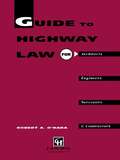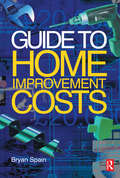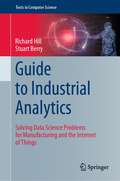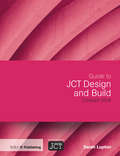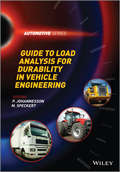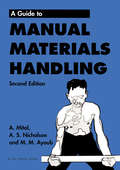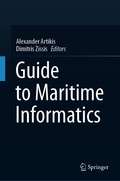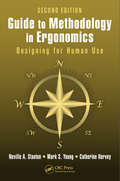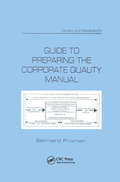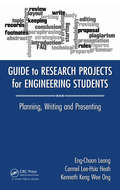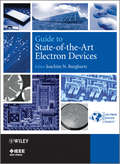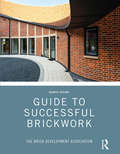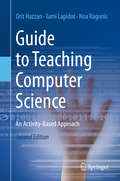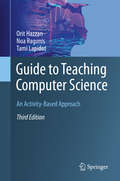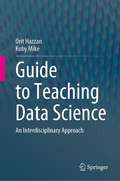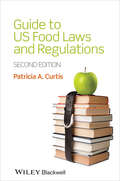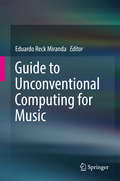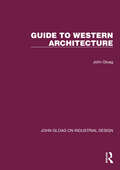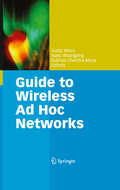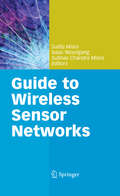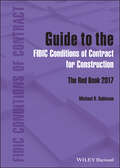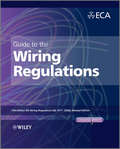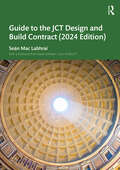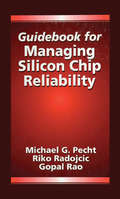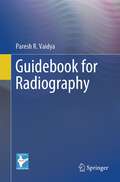- Table View
- List View
Guide to Highway Law for Architects, Engineers, Surveyors and Contractors
by Mr R O'Hara R.A. O'HaraFirst Published in 2004. Routledge is an imprint of Taylor & Francis, an informa company.
Guide to Home Improvement Costs
by Bryan SpainExtending your home? New kitchen or bathroom? Planning to decorate? If you're taking on a job like this you need to know three things - can you do it on your own; how long is going to take; and most important of all, how much is it going to cost.This book tells you the answers. With simple-to-follow guidance on all your home improvement projects it tells you:· the time the job will take· the costs of the materials· how difficult it's going to be· and what a professional is going to charge to do it for you
Guide to Industrial Analytics: Solving Data Science Problems for Manufacturing and the Internet of Things (Texts in Computer Science)
by Richard Hill Stuart BerryThis textbook describes the hands-on application of data science techniques to solve problems in manufacturing and the Industrial Internet of Things (IIoT). Monitoring and managing operational performance is a crucial activity for industrial and business organisations. The emergence of low-cost, accessible computing and storage, through Industrial Digital Technologies (IDT) and Industry 4.0, has generated considerable interest in innovative approaches to doing more with data. Data science, predictive analytics, machine learning, artificial intelligence and general approaches to modelling, simulating and visualising industrial systems have often been considered topics only for research labs and academic departments.This textbook debunks the mystique around applied data science and shows readers, using tutorial-style explanations and real-life case studies, how practitioners can develop their own understanding of performance to achieve tangible business improvements. All exercises can be completed with commonly available tools, many of which are free to install and use.Readers will learn how to use tools to investigate, diagnose, propose and implement analytics solutions that will provide explainable results to deliver digital transformation.
Guide to JCT Design and Build Contract 2016: Contract 2016
by Sarah LuptonGuide to JCT Design and Build Contract 2016, the new edition of the author's ever popular Guide to DB11, is a practical guide to the operation and administration of the JCT Design & Build Building Contract suite 2016. All of the contract's provisions, procedures and conditions are organised and explained by subject, clearly distinguishing the different obligations due to various parties and the contractual issues arising during the course of a job - all backed up by the latest legislation and case law. Not only is this an indispensable reference for the hard-pressed practitioner, but, assuming no prior knowledge of JCT contracts or the law, it is also ideal for architecture and other construction students on the threshold of undertaking their professional exams.
Guide to Load Analysis for Durability in Vehicle Engineering
by M. Speckert P. JohannessonThe overall goal of vehicle design is to make a robust and reliable product that meets the demands of the customers and this book treats the topic of analysing and describing customer loads with respect to durability.Guide to Load Analysis for Vehicle and Durability Engineering supplies a variety of methods for load analysis and also explains their proper use in view of the vehicle design process. In Part I, Overview, there are two chapters presenting the scope of the book as well as providing an introduction to the subject. Part II, Methods for Load Analysis, describes useful methods and indicates how and when they should be used. Part III, Load Analysis in view of the Vehicle Design Process, offers strategies for the evaluation of customer loads, in particular characterization of customer populations, which leads to the derivation of design loads, and finally to the verification of systems and components.Key features:* Is a comprehensive collection of methods for load analysis, vehicle dynamics and statistics* Combines standard load data analysis methods with statistical aspects on deriving test loads from surveys of customer usage* Sets the methods used in the framework of system dynamics and response, and derives recommendations for the application of methods in engineering practice* Presents a reliability design methodology based on statistical evaluation of component strength and customers loads* Includes case studies and illustrative examples that translate the theory into engineering practiceDeveloped in cooperation with six European truck manufacturers (DAF, Daimler, Iveco, MAN, Scania and Volvo) to meet the needs of industry, Guide to Load Analysis for Vehicle and Durability Engineering provides an understanding of the current methods in load analysis and will inspire the incorporation of new techniques in the design and test processes.
Guide to Manual Materials Handling (Guide Book Ser.)
by A. MitalManual Materials Handling MMH creates special problems for many different workers worldwide. Labourers engaged in jobs which require extensive lifting/lowering, carrying and pushing/pulling of heavy materials have suffered increasing rates of musculo-skeletal injury, especially to the back.; This guide is intended to include all activities involved in MMH lifting, pushing, pulling, carrying and holding. Recommendations are provided in the form of design data that can be used to design different MMH work activities.The guide is divided into two parts. Part I outlines the scope of the problem, discusses the factors that influence a person's capacity to perform MMH activities and / or should be modified to reduce the risk of injuries, and reviews the various design approaches to solving the MMH problem. Part II provides specific design data in six distinct chapters. The seventh chapter of Part II of the guide describes various mechanical devices that are available to aid MMH activities.; The guide is aimed at all concerned with the health impact of MMH activities; occupational health and safety workers; senior human resource managers; ergonomists; workers' compensation lawyers; union representatives.
Guide to Maritime Informatics
by Alexander Artikis Dimitris ZissisIn the last 25 years, information systems have had a disruptive effect on society and business. Up until recently though, the majority of passengers and goods were transported by sea in many ways similar to the way they were at the turn of the previous century. Gradually, advanced information technologies are being introduced, in an attempt to make shipping safer, greener, more efficient, and transparent. The emerging field of Maritime Informatics studies the application of information technology and information systems to maritime transportation.Maritime Informatics can be considered as both a field of study and domain of application. As an application domain, it is the outlet of innovations originating from data science and artificial intelligence; as a field of study, it is positioned between computer science and marine engineering. This new field’s complexity lies within this duality because it is faced with disciplinary barriers yet demands a systemic, transdisciplinary approach. At present, there is a growing body of knowledge that remains undocumented in a single source or textbook designed to assist students and practitioners.This highly useful textbook/reference starts by introducing required knowledge, algorithmic approaches, and technical details, before presenting real-world applications. The aim is to present interested audiences with an overview of the main technological innovations having a disruptive effect on the maritime industry, as well as to discuss principal ideas, methods of operation and applications, and future developments. The material in this unique volume provides requisite core knowledge for undergraduate or postgraduate students, employing an analytical approach with numerous real-world examples and case studies.
Guide to Methodology in Ergonomics: Designing for Human Use, Second Edition
by Mark S. Young Catherine Harvey Neville A. StantonPacked with illustrations and practical examples, Guide to Methodology in Ergonomics: Designing for Human Use, Second Edition provides a concise introduction to ergonomics methods in a straightforward manner that helps you conduct an ergonomics analysis of a product in development. It details the execution of 12 ergonomics methods that can be appli
Guide to Preparing the Corporate Quality Manual (Quality And Reliability Ser. #51)
by Bernard FromanUtilizes advanced concepts, guidelines and requirements from the latest ISO 9000 and 10000 series of standards, as well as other models, including TQM (Total Quality Managment). The text shows how to define a policy and explain it clearly. It offers procedures for developing a quality manual, to be used by personnel performing quality-related functions and for external auditors and customers.
Guide to Research Projects for Engineering Students: Planning, Writing and Presenting
by Eng Choon Leong Carmel Lee-Hsia Heah Kenneth Keng OngPresents an Integrated Approach, Providing Clear and Practical GuidelinesAre you a student facing your first serious research project? If you are, it is likely that you'll be, firstly, overwhelmed by the magnitude of the task, and secondly, lost as to how to go about it. What you really need is a guide to walk you through all aspects of the researc
Guide to State-of-the-Art Electron Devices
by Joachim N. BurghartzConcise, high quality and comparative overview of state-of-the-art electron device development, manufacturing technologies and applicationsGuide to State-of-the-Art Electron Devices marks the 60th anniversary of the IRE electron devices committee and the 35th anniversary of the IEEE Electron Devices Society, as such it defines the state-of-the-art of electron devices, as well as future directions across the entire field.Spans full range of electron device types such as photovoltaic devices, semiconductor manufacturing and VLSI technology and circuits, covered by IEEE Electron and Devices SocietyContributed by internationally respected members of the electron devices communityA timely desk reference with fully-integrated colour and a unique lay-out with sidebars to highlight the key termsDiscusses the historical developments and speculates on future trends to give a more rounded picture of the topics coveredA valuable resource R&D managers; engineers in the semiconductor industry; applied scientists; circuit designers; Masters students in power electronics; and members of the IEEE Electron Device Society.
Guide to Successful Brickwork
by Brick Development AssociationThe BDA Guide to Successful Brickwork is the definitive practical guide to obtaining successful results in brickwork construction. Written by a team of experts from the Brick Development Association, the representative group in industry for brickwork construction, this best-selling text has now been brought fully in line with the latest site practice, innovations, British and European Standards, to ensure readers are receiving the most up-to-date and accurate information available in the field. Based on actual teaching practice, the book is highly illustrated throughout to increase accessibility of the text for the reader in their exploration of the practical aspects of brickwork. It also includes an extensive glossary of brickwork terms for ease of reference. This edition contains new material detailing recent innovations in brickwork, in the areas of components and façade performance requirements. Students in full-time education and following apprenticeship routes will find this book to be an invaluable source of information which will accompany them throughout their studies. Building professionals concerned with the design, detailing and specification of brickwork will also find the BDA Guide to be an essential reference.
Guide to Teaching Computer Science
by Tami Lapidot Orit Hazzan Noa RagonisThis guide presents both a conceptual framework and detailed implementation guidelines for general computer science (CS) teaching. The content is clearly written and structured to be applicable to all levels of CS education and for any teaching organization, without limiting its focus to instruction for any specific curriculum, programming language or paradigm. Features: presents an overview of research in CS education; examines strategies for teaching problem-solving, evaluating pupils, and for dealing with pupils' misunderstandings; provides learning activities throughout the book; proposes active-learning-based classroom teaching methods, as well as methods specifically for lab-based teaching; discusses various types of questions that a CS instructor, tutor, or trainer can use for a range of different teaching situations; investigates thoroughly issues of lesson planning and course design; describes frameworks by which prospective CS teachers gain their first teaching experience.
Guide to Teaching Computer Science: An Activity-Based Approach
by Tami Lapidot Orit Hazzan Noa RagonisThis concise yet thorough textbook presents an active-learning model for the teaching of computer science. Offering both a conceptual framework and detailed implementation guidelines, the work is designed to support a Methods of Teaching Computer Science (MTCS) course, but may be applied to the teaching of any area of computer science at any level, from elementary school to university. This text is not limited to any specific curriculum or programming language, but instead suggests various options for lesson and syllabus organization.Fully updated and revised, the third edition features more than 40 new activities, bringing the total to more than 150, together with new chapters on computational thinking, data science, and soft concepts and soft skills. This edition also introduces new conceptual frameworks for teaching such as the MERge model, and new formats for the professional development of computer science educators.Topics and features: includes an extensive set of activities, to further support the pedagogical principles outlined in each chapter; discusses educational approaches to computational thinking, how to address soft concepts and skills in a MTCS course, and the pedagogy of data science (NEW); focuses on teaching methods, lab-based teaching, and research in computer science education, as well as on problem-solving strategies; examines how to recognize and address learners’ misconceptions, and the different types of questions teachers can use to vary their teaching methods; provides coverage of assessment, teaching planning, and designing a MTCS course; reviews high school teacher preparation programs, and how prospective teachers can gain experience in teaching computer science.This easy-to-follow textbook and teaching guide will prove invaluable to computer science educators within all frameworks, including university instructors and high school teachers, as well as to instructors of computer science teacher preparation programs.
Guide to Teaching Data Science: An Interdisciplinary Approach
by Orit Hazzan Koby MikeData science is a new field that touches on almost every domain of our lives, and thus it is taught in a variety of environments. Accordingly, the book is suitable for teachers and lecturers in all educational frameworks: K-12, academia and industry.This book aims at closing a significant gap in the literature on the pedagogy of data science. While there are many articles and white papers dealing with the curriculum of data science (i.e., what to teach?), the pedagogical aspect of the field (i.e., how to teach?) is almost neglected. At the same time, the importance of the pedagogical aspects of data science increases as more and more programs are currently open to a variety of people.This book provides a variety of pedagogical discussions and specific teaching methods and frameworks, as well as includes exercises, and guidelines related to many data science concepts (e.g., data thinking and the data science workflow), main machine learning algorithms and concepts (e.g., KNN, SVM, Neural Networks, performance metrics, confusion matrix, and biases) and data science professional topics (e.g., ethics, skills and research approach).Professor Orit Hazzan is a faculty member at the Technion’s Department of Education in Science and Technology since October 2000. Her research focuses on computer science, software engineering and data science education. Within this framework, she studies the cognitive and social processes on the individual, the team and the organization levels, in all kinds of organizations.Dr. Koby Mike is a Ph.D. graduate from the Technion's Department of Education in Science and Technology under the supervision of Professor Orit Hazzan. He continued his post-doc research on data science education at the Bar-Ilan University, and obtained a B.Sc. and an M.Sc. in Electrical Engineering from Tel Aviv University.
Guide to US Food Laws and Regulations
by Patricia A. CurtisFor both student food scientists and experienced professionals, a knowledge of U.S. food law is the foundation that supports an understanding of all industry regulation. Based on a popular internet course, Guide to Food Laws and Regulations, 2nd Edition informs students on the significance, range, and background of food laws and gives tools for finding current regulations. This compact resource outlines major U.S. food laws, factors that led to their passage, and explains the role of key agencies like the FDA and FSIS in regulation and enforcement. Students are directed to internet sites as well as to indexes and resources available from the Federal government. Other topics include religious dietary law, Occupational Safety and Health Administration regulations, environmental regulations, HACCP and GMPs, laws governing health claims, and the regulation of biotechnology. New to this edition are six chapters on subjects that have risen to prominence during the last few years: Poultry Processing Regulations Federal Trade Commission Animal Welfare Regulations and Food Production Egg Laws and Regulations Catfish Regulations Locating Laws and Regulations Guide to Food Laws and Regulations, 2nd Edition is an ideal sourcebook for students and professionals in food science and technology, chemistry, biosystems engineering, food animal production and medicine, agribusiness, and other closely related fields.
Guide to Unconventional Computing for Music
by Eduardo Reck MirandaThis pioneering text/reference explores how innovative new modes of computation may provide exciting new directions for future developments in the music industry, guiding the reader through the latest research in this emerging, interdisciplinary field. This work includes coverage of electronic music compositions and performances that incorporate unconventional interfacing, hacking and circuit bending. Features: presents an introduction to unconventional computing in music; discusses initiatives involving biophysical electronic music, the work of self-styled silicon luthiers, and the intersection of music and quantum computing; introduces the memristor, a new electronic component with the potential to revolutionize how computers are built; reviews experiments and practical applications of biological memristors in music; describes IMUSIC, an unconventional tone-based programming language, which enables the programming of computers using musical phrases; includes review questions at the end of each chapter.
Guide to Western Architecture
by John GloagOriginally published in 1958, A Guide to Western Architecture charts the origins of the system of architectural design that was perfected in Greece, follows its development under the Roman Empire and describes the achievements of the Byzantine architects. Passing through Romanesque to Gothic, the contributions made by Mediaeval builders to structure and design are recorded, and then the impact of the Renaissance on architecture, and its characteristic development in the different European countries. The transplanting of Renaissance ideas to the New World is covered, and finally the origins and nature of the new Western architecture occupy the last section of the book. The Appendix includes a list of the principal architects, and brief notes on their work, from the 5th century B. C. to the end of the Renaissance.
Guide to Wireless Ad Hoc Networks
by Isaac Woungang Subhas Chandra Misra Sudip MisraWireless communication technologies have been undergoing rapid advancements, however there are several challenges that still need to be addressed. This book provides a comprehensive guide on the new ideas and results in the areas of mobile ad hoc networks, sensor networks and other ad hoc and ubiquitous computing systems, all in the wireless communication technology field. Wireless ad hoc networks and ubiquitous computing are explored by leading experts in the field from both academia and industry, with various challenges in diverse environments, standards, routing mechanisms, etc. This comprehensive book features in-depth descriptions of terminologies and concepts related to the diverse subject areas in wireless communication. This wide-ranging text will be a valuable reference for researchers, students, instructors, engineers, and strategists seeking the state of the art in the field.
Guide to Wireless Sensor Networks
by Isaac Woungang Subhas Chandra Misra Sudip MisraWireless communication technologies continue to undergo rapid advancement. In recent years, there has been a steep growth in research in the area of wireless sensor networks (WSNs). In WSNs, communication takes place with the help of spatially distributed, autonomous sensor nodes equipped to sense specific information. WSNs can be found in a variety of both military and civilian applications worldwide. Examples include detecting enemy intrusion on the battlefield, object tracking, habitat monitoring, patient monitoring and fire detection. Sensor networks are emerging as an attractive technology with great promise for the future. However, challenges remain to be addressed in issues relating to coverage and deployment, scalability, quality-of-service, size, computational power, energy efficiency and security. This highly useful guide presents a comprehensive account of the fundamental concepts, new ideas and results in the field of WSNs.
Guide to the FIDIC Conditions of Contract for Construction: The Red Book 2017
by Michael D. RobinsonEnables readers to easily understand the contract to enable better compliance and efficiency Guide to the FIDIC Conditions of Contract for Construction: The Red Book 2017 helps the reader overcome some of the difficulties encountered on a typical international construction project using the FIDIC Construction Contract 2nd Edition (the 2017 Red Book), by summarizing the activities and duties of those involved, and crystallizing the requirements of the contract. To aid in reader comprehension, the text explains clauses in the sequence they appear in the contract, but also in the order they happen in real time on site. It further provides practical guidance in a concise manner, and in straightforward, jargon-free language. It is a highly practical resource for use during the project, rather than a legal review of the contractual requirements, ensuring readers are fully conversant with the revised requirements and procedures mandated by the 2017 edition of the contract. Guide to the FIDIC Conditions of Contract for Construction: The Red Book 2017 includes: A review of the duties and responsibilities of the three parties, the Employer, the Engineer and the Contractor, engaged on a FIDIC-based Contract A review of the flow of documentation and instructions which is to be provided by one party to another party throughout the contract period Practical guidelines are provided for the avoidance of disputes and delays in order that contracts are completed as plannedGuide to the FIDIC Conditions of Contract for Construction: The Red Book 2017 is a practical and highly useful resource for engineers, consultants, project managers, and others who are engaged in the site management of international projects using the FIDIC Construction Contract, along with those involved in contractual administration on behalf of the client.
Guide to the IET Wiring Regulations
by Electrical Contractors' AssociationThis authoritative, best-selling guide has been extensively updated with the new technical requirements of the IET Wiring Regulations (BS 7671: 2008) Amendment No. 1:2011, also known as the IET Wiring Regulations 17th Edition. With clear description, it provides a practical interpretation of the amended regulations - effective January 2012 - offers real solutions to the problems that can occur in practice.This revised edition features:new material on hot topics such as electromagnetic compatibility (EMC), harmonics, surge protective devices, and new special locations including medical locations, and operative or maintenance gangways;highlights the changes that have been made in this latest Amendment and their impact in practice;examples of how to comply with the Wiring Regulations;fully-integrated colour including sixty brand new colour illustrations, twenty tables and new high-quality photographs.This essential guide retains its handy format, ideal for practicing electricians, trainee electricians and apprentices to carry with them for quick reference. It is a valuable resource for all users of BS 7671 who want to understand the background to the Regulations; electrical engineers and technicians, installation and design engineers, consulting and building services engineers, also dedicated inspectors and testers.
Guide to the JCT Design and Build Contract - 2024 Edition
by Seán Mac LabhraíThis book provides a comprehensive guide to the 2024 edition of the JCT Design and Build Contract. It offers a straightforward reference to help practitioners understand the rights and obligations of the parties, and to administrate the Contract in an accurate and timely manner.Part 1 provides commentary on all the key provisions of the Contract, in plain English. It adopts the same structure as the Contract and includes the relevant extracts to reduce the need for cross-referencing. There is also guidance on current market practice, and recommendations for best practice.Part 2 contains over 300 corresponding resources for the administration of the Contract, by both the Contractor and the Employer. It includes notice and other correspondence templates, checklists, and trackers to assist record keeping.Written to meet the needs of busy construction practitioners, this is an accessible, practical reference for those acting on behalf of the Contractor and the Employer (and Employer’s Agent), including project teams, consultants, and advisors. It is also ideally suited for students of construction law.
Guidebook for Managing Silicon Chip Reliability (Electronic Packaging #5)
by Riko Radojcic Michael Pecht Gopal RaoAchieving cost-effective performance over time requires an organized, disciplined, and time-phased approach to product design, development, qualification, manufacture, and in-service management. Guidebook for Managing Silicon Chip Reliability examines the principal failure mechanisms associated with modern integrated circuits and describes common practices used to resolve them.This quick reference on semiconductor reliability addresses the key question: How will the understanding of failure mechanisms affect the future?Chapters discuss:failure sites, operational loads, and failure mechanismintrinsic device sensitivitieselectromigrationhot carrier agingtime dependent dielectric breakdownmechanical stress induced migrationalpha particle sensitivityelectrostatic discharge (ESD) and electrical overstresslatch-upqualificationscreeningguidelines for designing reliabilityGuidebook for Managing Silicon Chip Reliability focuses on device failure and causes throughout - providing a thorough framework on how to model the mechanism, test for defects, and avoid and manage damage. It will serve as an exceptional resource for electrical engineers as well as mechanical engineers working in the field of electronic packaging.
Guidebook for Radiography
by Paresh R. VaidyaThis book is a complete and compact manual on the radiographic testing. It covers every aspect of the test method including radiation safety and its modern techniques. It is specifically designed as a quick guide and reference manual for field engineers. There are chapters on basic physics of radiation, radiographic equipment, radiographic film and screen, radiography application and techniques, among others. The contents also include pedagogical features such as end-of-chapter numerical problems and chapters on ‘How to write Procedure for Testing’ and ‘How to write Instructions for Testing’ which are practical tips that are not found in standard textbooks. This book is a useful resource for professionals and researchers in the areas of radiography and radiometry.
